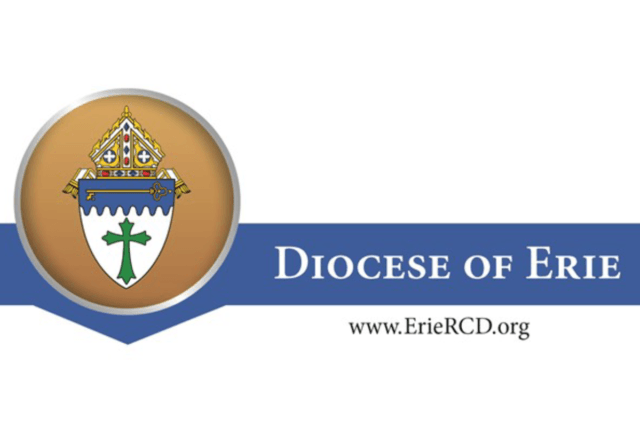Pastors and leaders from parishes in Erie County met with the Most Rev. Lawrence T. Persico, bishop of Erie, April 11 as he unveiled a new configuration of Catholic parishes for the county. Parishioners in the area have been awaiting the announcement since a preliminary plan was put forth Aug. 29, 2023.
The plan involves:
- Mergers, through which one parish community is absorbed into another;
- Partnerships, through which two or more parishes share one pastor;
- A combination of merger and partnership that involves one parish community being absorbed into another before partnering with a third parish, with whom it will share a pastor.
Each new situation involves a decree from Bishop Persico, all of which will go into effect July 9, 2024. Prior to that time, several clergy will need to be reassigned in order to align with the new configurations. Those announcements will be made later this spring.
Father Nicholas Rouch, vicar general, discussed the process for decision making. The decisions were driven by data, he said, including hard numbers such as Mass attendance, priest availability, church capacity, distances between churches and parish indebtedness.
“The data driving the decisions also includes information provided by over 1,100 individuals who submitted feedback in addition to official responses prayerfully offered by pastors after consulting parishioners and parish councils,” he said. The plan also was discussed and refined with the diocesan-wide priest council on three separate occasions.
Father Rouch acknowledged the need for a review of Mass times in Erie County. He said there are obvious cases, such as situations in which one pastor will now be serving two partnered parishes, where decisions will have to be made quickly.
“But given all that will be unfolding in the next two months, with both parish restructuring and clergy assignments, out of respect for your emotional integrity and ours, we are going to wait a bit before taking that on across the county.” He said a more comprehensive review of Mass times at all parishes in Erie County would be revisited when the dust settles.
“This is especially important to our brothers and sisters in other counties of the diocese, who depend on priests in the Erie area to provide coverage when they have to be out of town or fall ill,” he said. “Right now we are very limited in what we can do in that situation.”
In his remarks, Bishop Persico pointed out that he will ordain one man to the priesthood in May and two next spring.
“Then we will have three years with no priestly ordinations, a time during which 16 of our priests will reach retirement age, which is 75,” he said, emphasizing the importance of implementing new parish configurations in order to lay the best possible foundation for the future.
Acknowledging that additional changes will be made in the future — ideally on a parish-by-parish basis rather than whole regions of the diocese — Bishop Persico offered a positive consideration.
“As we move into new configurations, we have an unexpected opportunity to renew our parishes, ensuring they are life-giving places of worship, places where people find encouragement and inspiration as they grow in their relationship with Christ, his church and each other,” he said. “That is really the only goal we have. To grow in our faith. To grow closer to Christ. And to help each other along the way.”
Please note several key distinctions on the list of parishes below:
- A parish refers to a community of people while a church refers to a building. A parish can have secondary churches, with or without mission status.
- A secondary mission church is permitted to have Mass on either Saturday evening or Sunday morning.
- A secondary church (without mission status) does not have a weekend Mass, but is still available for weddings, funerals and in some cases, a weekday Mass.









